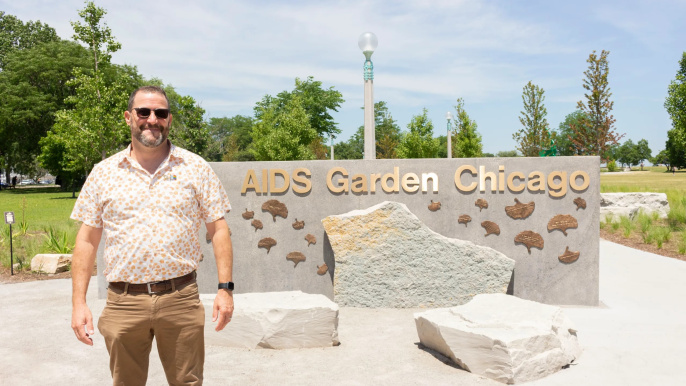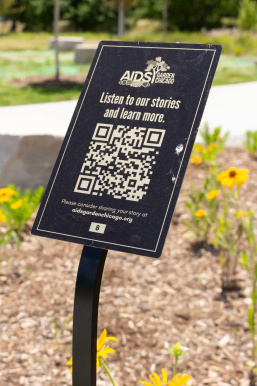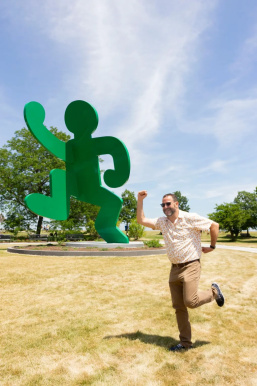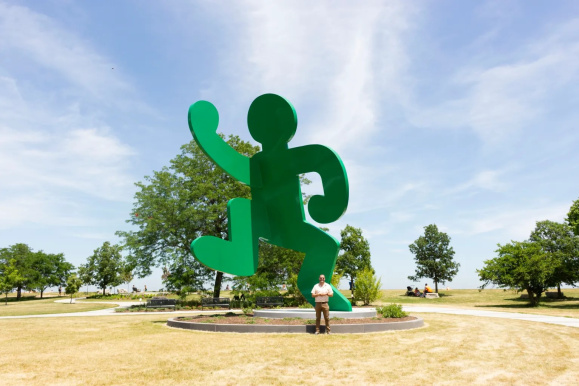



|
Chicago, IL United States |
Belmont Harbor | AIDS Garden Chicago |
since 20 December 2019 unknown |
Yoni Pizer Sees AIDS Garden Chicago As A “Park With A Purpose”
Through AIDS Garden Chicago, board chair Yoni Pizer and others hope to honor those affected by the HIV/AIDS crisis — and those continuing the fight today.
Yoni Pizer is board chair of AIDS Garden Chicago, a two and a half acre memorial to those lost during the HIV/AIDS crisis. Pizer moved to Chicago after graduating from the University of Wisconsin-Madison and was captivated by the excitement of a big city. He enjoys the simple pleasures of Chicago, like bike-riding on the lakefront and playing tennis at the Waveland Courts. Pizer has been a resident of the Lakeview neighborhood for 30 years, and served in 2020 as the first openly gay state representative in the city’s 12th District.
Opened June 2, the garden is the city’s first public monument memorializing the HIV/AIDS crisis. Through the memorial garden, Pizer and others hope to honor those affected during the early days of the epidemic as well as the activists and community members still fighting today.
With U.S. cases first reported in 1981, the HIV/AIDS epidemic became one of the primary public health crises in the country throughout the ‘80s into the early ‘90s. The U.S. government, however, did little to address the crisis at the time, largely attributed to the fact gay men were one of the primary groups impacted by HIV/AIDS. Ronald Reagan, president at the time, first publicly mentioned AIDS in 1985, four years after cases were initially reported. That year, new cases of HIV/AIDS had increased by 89% compared to the year prior.
As the ‘80s went on, the number of new cases and HIV/AIDS-related deaths continued to rise. The gay community was forced to fight massive pushback and intolerance at the same time it was fighting the virus, which was labeled and joked about by White House press secretary Larry Speakes and other members of the media as the “gay plague” in 1982 — when the American HIV/AIDS death toll was nearly 1,000. Hospitals, healthcare providers and the media vilified those affected and left them without the care they deserved.
The virus has taken the lives of more than 36 million individuals as of 2020, but today, though there is still no cure, advances in medical research, prevention and treatment have given hope to the millions living with or at risk of developing HIV.
Though an HIV/AIDS memorial, as Pizer stated, has been activists’ goal for decades, AIDS Garden Chicago was first idealized by Ald. Tom Tunney in 2005. Work on the actual green space began in 2019, with the installation of the garden’s centerpiece; visible from Lake Shore Drive, Keith Haring’s bright green, 30-foot sculpture titled “Self-Portrait” towers over the garden. Haring, also an HIV/AIDS activist throughout the ‘80s, passed away in 1990 due to complications with AIDS at the age of 31.
The garden exists not just to memorialize those lost to the virus, but to continue the fight against bigotry. It strives to preserve the history of the epidemic’s early days in Chicago with its “Story Archive,” a digital quilt of personal and community stories corresponding to signs with numbered QR codes around the garden.
AIDS Garden Chicago is also located at the original location of the Belmont Rocks on the Chicago Riverfront, a key gathering place for Chicago’s gay community for nearly 30 years — where Pizer himself used to spend time before they were demolished in 2003, as part of a shoreline fortification project. Some of the rocks are now placed around the garden as seating areas and landscaping pieces.
The memorial is continually evolving to better share the stories of those who have been affected by HIV/AIDS. As someone who enjoys the lakefront himself, Pizer wants to further the park’s development so it can continue to be a welcoming and meaningful space for the LGBTQ community for decades to come. This is what his Chicago sounds like.
What is AIDS Garden Chicago?
The AIDS Garden is a park with a purpose — that’s what we like to say. It’s two and a half acres of sort of a memorial to the fight against HIV and AIDS. It memorializes the early days and those who we tragically lost and the battles that we were forced to fight for the community when our government, when our insurance carriers, when our employers, when too many political leaders, at best, turned their back at us and ignored us and ignored the plague. And at worst, demonized us, ostracized us and really sort of painted it as, you know, the “gay plague” and really did nothing to help us. So, what did we do? We united. We organized. We fought. We set up our own organizations… many of which are still here today with us.
Are you from Chicago? What brought you here if not?
I am originally from Madison, Wisconsin, but I’ve been in Chicago for 36 years. I could feel the draw coming to Chicago as soon as I graduated from Madison. I’ve really found my true home here in Chicago. I currently live in East Lakeview, I’ve lived on the same street for 30 years. I love the excitement of a big city. I think Chicago is a beautiful place. I know it sounds so trite, but I really do love riding my bike on the lakefront and going for long walks and I’m an avid tennis player. I love playing tennis at Waveland outside in the summer, actually into the fall and winter and spring if I can, if it’s a nice day and a lot of sun. I’m kind of an architecture buff. I love all the history of architecture. I love calling it home.
Why is AIDS Garden located at Belmont Harbor?
The AIDS Garden Chicago, in the 44th Ward, on the lakefront where the historic Belmont Rocks used to be, has been a dream of several activists in the community for literally decades. It’s a unique spot to have something dedicated to HIV and AIDS. The Belmont Rocks, for those people who don’t know, was [an] incredible LGBTQ meeting place in the ’70s and ’80s along the lakefront, right south of Belmont Harbor. It was called Belmont Rocks because it was basically just a bunch of the rocks that the Army Corps of Engineers had put on the lakefront to try to prevent erosion. And the LGBTQ community just sort of took it over as our own.
That was a time when people were still getting arrested. There were still bar raids. When people get fired for being gay. When gay bars, the few that there were, had darkened windows, so you couldn’t see inside. To have a place in Chicago, under the sun, outdoors, in a beautiful setting with the lake and views of downtown where you could just be you, and free and carefree was amazing.
It was true that not everyone felt welcome there. You know, people of color often felt like they didn’t belong there. Which… it obviously saddens me, because they were experiencing the same thing on Halsted Street. And… with the AIDS Garden itself, that project, that’s something that we’re striving to continually improve in terms of our board, in terms of the stories that people can hear on the website and as they stroll through the garden.
Walk us through the AIDS Garden. What is it like?
The centerpiece is a 30-foot tall Keith Haring sculpture called “Self-Portrait.” It’s the largest Keith Haring sculpture in the world. “It takes my breath away every time you see it. You see it on a picture of it without anyone standing around it like, ‘Oh, that’s cool!’ And then you realize…’” “It’s giant!”
Keith Haring is an AIDS activist artist who spent a lot of time in Chicago. Died of AIDS… well before his time, like, sadly, so many other people in the community. And I just feel so fortunate that this is sort of the centerpiece of the AIDS Garden.
There is a ginkgo tree, eventually it’s going to be a ginkgo tree forest, on one part of it. There are benches throughout, but there’s one area right along the lake, which is the Garden of Reflection where we want people to feel that they can go and think about people that they’ve lost, perhaps. But it’s not only retrospective, it’s not only looking back at where we were. It’s also here and now, and where we’re going in the future.
Why is it important to commemorate the history of AIDS this way?
There are so many people that are still getting infected today. It’s not a thing of the past, although so many people seem to think that it doesn’t affect people anymore. It still does. And, in one place, we also have the words of Danny Sotomayor, who’s a Chicago AIDS activist, I think, who would be very proud of the AIDS Garden right there, at the former site of the Belmont Rocks.
We have a story archive portion of the website. And what’s really cool is, as you walk through the garden, there are stanchions with QR codes that link to Chicagoans telling their stories of HIV and AIDS. And that’s going to be something that we’re going to grow, and grow and grow. It’s going to be an oral tapestry quilt of experiences from everyday Chicagoans. We’re also going to have… programming in the park throughout the year and not just on AIDS Day, December 1, and during pride month. We’re really going to have broad programming.
AIDS Garden Chicago is truly a community and a collaborative effort. We really want it to be a gathering space for the community, where everyone feels welcome and understands the importance of community, of fighting for things that are important.
Photos © Morgan Ciocca Vocalo
14 July 2022
Vocalo Radio, Chicago, IL
Through AIDS Garden Chicago, board chair Yoni Pizer and others hope to honor those affected by the HIV/AIDS crisis — and those continuing the fight today.
Yoni Pizer is board chair of AIDS Garden Chicago, a two and a half acre memorial to those lost during the HIV/AIDS crisis. Pizer moved to Chicago after graduating from the University of Wisconsin-Madison and was captivated by the excitement of a big city. He enjoys the simple pleasures of Chicago, like bike-riding on the lakefront and playing tennis at the Waveland Courts. Pizer has been a resident of the Lakeview neighborhood for 30 years, and served in 2020 as the first openly gay state representative in the city’s 12th District.
Opened June 2, the garden is the city’s first public monument memorializing the HIV/AIDS crisis. Through the memorial garden, Pizer and others hope to honor those affected during the early days of the epidemic as well as the activists and community members still fighting today.
With U.S. cases first reported in 1981, the HIV/AIDS epidemic became one of the primary public health crises in the country throughout the ‘80s into the early ‘90s. The U.S. government, however, did little to address the crisis at the time, largely attributed to the fact gay men were one of the primary groups impacted by HIV/AIDS. Ronald Reagan, president at the time, first publicly mentioned AIDS in 1985, four years after cases were initially reported. That year, new cases of HIV/AIDS had increased by 89% compared to the year prior.
As the ‘80s went on, the number of new cases and HIV/AIDS-related deaths continued to rise. The gay community was forced to fight massive pushback and intolerance at the same time it was fighting the virus, which was labeled and joked about by White House press secretary Larry Speakes and other members of the media as the “gay plague” in 1982 — when the American HIV/AIDS death toll was nearly 1,000. Hospitals, healthcare providers and the media vilified those affected and left them without the care they deserved.
The virus has taken the lives of more than 36 million individuals as of 2020, but today, though there is still no cure, advances in medical research, prevention and treatment have given hope to the millions living with or at risk of developing HIV.
Though an HIV/AIDS memorial, as Pizer stated, has been activists’ goal for decades, AIDS Garden Chicago was first idealized by Ald. Tom Tunney in 2005. Work on the actual green space began in 2019, with the installation of the garden’s centerpiece; visible from Lake Shore Drive, Keith Haring’s bright green, 30-foot sculpture titled “Self-Portrait” towers over the garden. Haring, also an HIV/AIDS activist throughout the ‘80s, passed away in 1990 due to complications with AIDS at the age of 31.
The garden exists not just to memorialize those lost to the virus, but to continue the fight against bigotry. It strives to preserve the history of the epidemic’s early days in Chicago with its “Story Archive,” a digital quilt of personal and community stories corresponding to signs with numbered QR codes around the garden.
AIDS Garden Chicago is also located at the original location of the Belmont Rocks on the Chicago Riverfront, a key gathering place for Chicago’s gay community for nearly 30 years — where Pizer himself used to spend time before they were demolished in 2003, as part of a shoreline fortification project. Some of the rocks are now placed around the garden as seating areas and landscaping pieces.
The memorial is continually evolving to better share the stories of those who have been affected by HIV/AIDS. As someone who enjoys the lakefront himself, Pizer wants to further the park’s development so it can continue to be a welcoming and meaningful space for the LGBTQ community for decades to come. This is what his Chicago sounds like.
What is AIDS Garden Chicago?
The AIDS Garden is a park with a purpose — that’s what we like to say. It’s two and a half acres of sort of a memorial to the fight against HIV and AIDS. It memorializes the early days and those who we tragically lost and the battles that we were forced to fight for the community when our government, when our insurance carriers, when our employers, when too many political leaders, at best, turned their back at us and ignored us and ignored the plague. And at worst, demonized us, ostracized us and really sort of painted it as, you know, the “gay plague” and really did nothing to help us. So, what did we do? We united. We organized. We fought. We set up our own organizations… many of which are still here today with us.
Are you from Chicago? What brought you here if not?
I am originally from Madison, Wisconsin, but I’ve been in Chicago for 36 years. I could feel the draw coming to Chicago as soon as I graduated from Madison. I’ve really found my true home here in Chicago. I currently live in East Lakeview, I’ve lived on the same street for 30 years. I love the excitement of a big city. I think Chicago is a beautiful place. I know it sounds so trite, but I really do love riding my bike on the lakefront and going for long walks and I’m an avid tennis player. I love playing tennis at Waveland outside in the summer, actually into the fall and winter and spring if I can, if it’s a nice day and a lot of sun. I’m kind of an architecture buff. I love all the history of architecture. I love calling it home.
Why is AIDS Garden located at Belmont Harbor?
The AIDS Garden Chicago, in the 44th Ward, on the lakefront where the historic Belmont Rocks used to be, has been a dream of several activists in the community for literally decades. It’s a unique spot to have something dedicated to HIV and AIDS. The Belmont Rocks, for those people who don’t know, was [an] incredible LGBTQ meeting place in the ’70s and ’80s along the lakefront, right south of Belmont Harbor. It was called Belmont Rocks because it was basically just a bunch of the rocks that the Army Corps of Engineers had put on the lakefront to try to prevent erosion. And the LGBTQ community just sort of took it over as our own.
That was a time when people were still getting arrested. There were still bar raids. When people get fired for being gay. When gay bars, the few that there were, had darkened windows, so you couldn’t see inside. To have a place in Chicago, under the sun, outdoors, in a beautiful setting with the lake and views of downtown where you could just be you, and free and carefree was amazing.
It was true that not everyone felt welcome there. You know, people of color often felt like they didn’t belong there. Which… it obviously saddens me, because they were experiencing the same thing on Halsted Street. And… with the AIDS Garden itself, that project, that’s something that we’re striving to continually improve in terms of our board, in terms of the stories that people can hear on the website and as they stroll through the garden.
Walk us through the AIDS Garden. What is it like?
The centerpiece is a 30-foot tall Keith Haring sculpture called “Self-Portrait.” It’s the largest Keith Haring sculpture in the world. “It takes my breath away every time you see it. You see it on a picture of it without anyone standing around it like, ‘Oh, that’s cool!’ And then you realize…’” “It’s giant!”
Keith Haring is an AIDS activist artist who spent a lot of time in Chicago. Died of AIDS… well before his time, like, sadly, so many other people in the community. And I just feel so fortunate that this is sort of the centerpiece of the AIDS Garden.
There is a ginkgo tree, eventually it’s going to be a ginkgo tree forest, on one part of it. There are benches throughout, but there’s one area right along the lake, which is the Garden of Reflection where we want people to feel that they can go and think about people that they’ve lost, perhaps. But it’s not only retrospective, it’s not only looking back at where we were. It’s also here and now, and where we’re going in the future.
Why is it important to commemorate the history of AIDS this way?
There are so many people that are still getting infected today. It’s not a thing of the past, although so many people seem to think that it doesn’t affect people anymore. It still does. And, in one place, we also have the words of Danny Sotomayor, who’s a Chicago AIDS activist, I think, who would be very proud of the AIDS Garden right there, at the former site of the Belmont Rocks.
We have a story archive portion of the website. And what’s really cool is, as you walk through the garden, there are stanchions with QR codes that link to Chicagoans telling their stories of HIV and AIDS. And that’s going to be something that we’re going to grow, and grow and grow. It’s going to be an oral tapestry quilt of experiences from everyday Chicagoans. We’re also going to have… programming in the park throughout the year and not just on AIDS Day, December 1, and during pride month. We’re really going to have broad programming.
AIDS Garden Chicago is truly a community and a collaborative effort. We really want it to be a gathering space for the community, where everyone feels welcome and understands the importance of community, of fighting for things that are important.
Photos © Morgan Ciocca Vocalo
14 July 2022
Vocalo Radio, Chicago, IL





























